“I feel good when I’m weaving,” says Rachael when I remind her that the Etsy stuff is supposed to be fun not an all-out push to get stuff done.
Whipping things off the loom…
The chef towels are a popular item on the Etsy store so Rachael put them back on the loom to make some more and use up colors.
The video here is a quick clip of the blue chef towels coming off the loom, because it’s kind of fun!
Unusual things occupy your childhood memories when you grow up in a weaver’s home… a repeating theme turns out to be your mother hauling yards and yards and yards of fabric off a loom (and not letting you help because you’re like 4 years old and this fabric is for a client and thus not to be messed up).
Changing warp colors, the easy way
The process of changing over the color without having to re-warp the entire loom is pretty simple but still rather awesome. When I got to her studio yesterday, Rachael had finished 15 blue chef towels and was already tying on a new color. She had already tied the new green warp to the ends of the blue warp and had moved on to tying on the white ends.
This is a shot from the back of the loom and the end of warp. The warp is tied onto the rod you see in the bottom of the picture, then threaded through the heddles on the harnesses and finally through the reed on the beater. The masking tape you see across the threads helps keep it tamed. When all the new warp threads are tied on, she’ll wind the length of the new warp onto the back beam of the loom so she can start weaving again.
Here you can see some of the length of the warp coming off the loom. Rachael is putting on enough warp for another 12+ green chef towels. It’s carefully prepared so that it keeps from tangling both before and during the warping process.

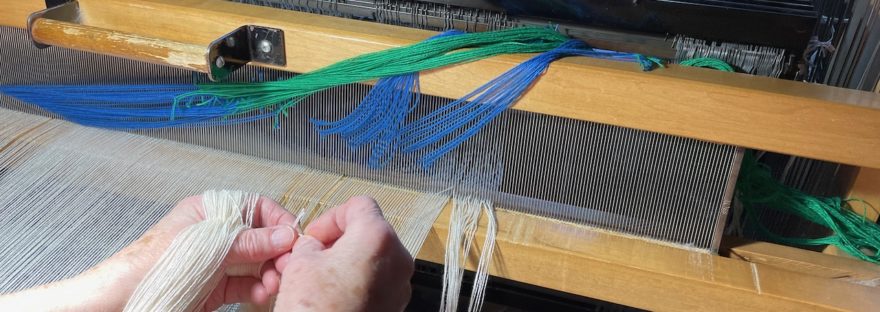
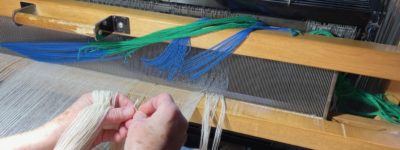
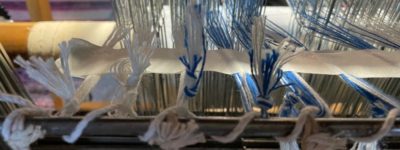
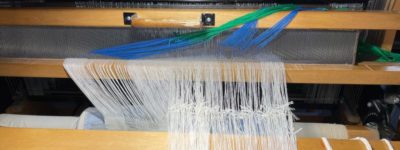
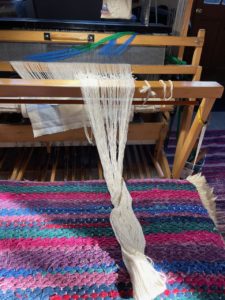
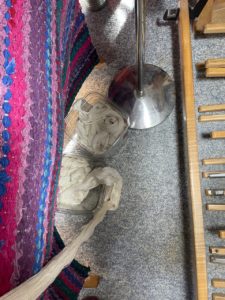
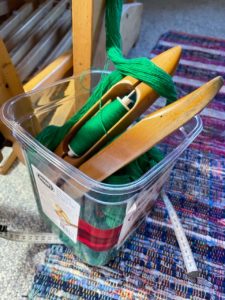
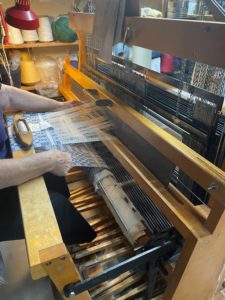
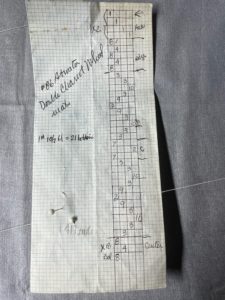 Each weave pattern has a specific treadle pattern that the weaver performs. Here you’ll see one of Rachael’s treadle charts for Double Chariot Wheel, complete with notes that I still can’t read 100% of despite my 40-something years of exposure to her handwriting. There are, however, repeats noted as well as edges and the center part of the pattern. Once she reaches the bottom of the treadle chart, she works her way back up to finish the other end of the piece. The number of repeats of each section determines the length of the piece, whether it’s short like a placement or longer like a table runner. Also noted here is “417 ends”: which is to say 417 of the white warp threads are on the loom, threaded through specific harnesses, to produce this pattern. Trust me, this is not a big number compared to some of Rachael’s other work.
Each weave pattern has a specific treadle pattern that the weaver performs. Here you’ll see one of Rachael’s treadle charts for Double Chariot Wheel, complete with notes that I still can’t read 100% of despite my 40-something years of exposure to her handwriting. There are, however, repeats noted as well as edges and the center part of the pattern. Once she reaches the bottom of the treadle chart, she works her way back up to finish the other end of the piece. The number of repeats of each section determines the length of the piece, whether it’s short like a placement or longer like a table runner. Also noted here is “417 ends”: which is to say 417 of the white warp threads are on the loom, threaded through specific harnesses, to produce this pattern. Trust me, this is not a big number compared to some of Rachael’s other work. 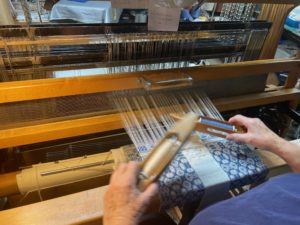 One of my favorite things about overshot is that it’s reversible. We’ve tried to catch both sides of each overshot piece in the photos for the shop for this reason. You can flip a runner or placemat when it gets a little dirty and use the other side and no one will know! You can also alternate the contrasting sides of the placemats when you set your holiday table for a beautiful effect. It’s also a good way to distinguish my placemat from my daughter’s at the table. And sometimes? I just like the lighter side better than the darker side…
One of my favorite things about overshot is that it’s reversible. We’ve tried to catch both sides of each overshot piece in the photos for the shop for this reason. You can flip a runner or placemat when it gets a little dirty and use the other side and no one will know! You can also alternate the contrasting sides of the placemats when you set your holiday table for a beautiful effect. It’s also a good way to distinguish my placemat from my daughter’s at the table. And sometimes? I just like the lighter side better than the darker side…